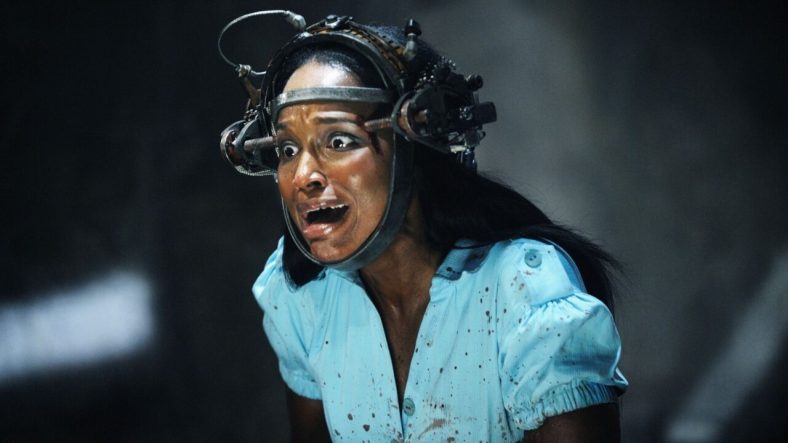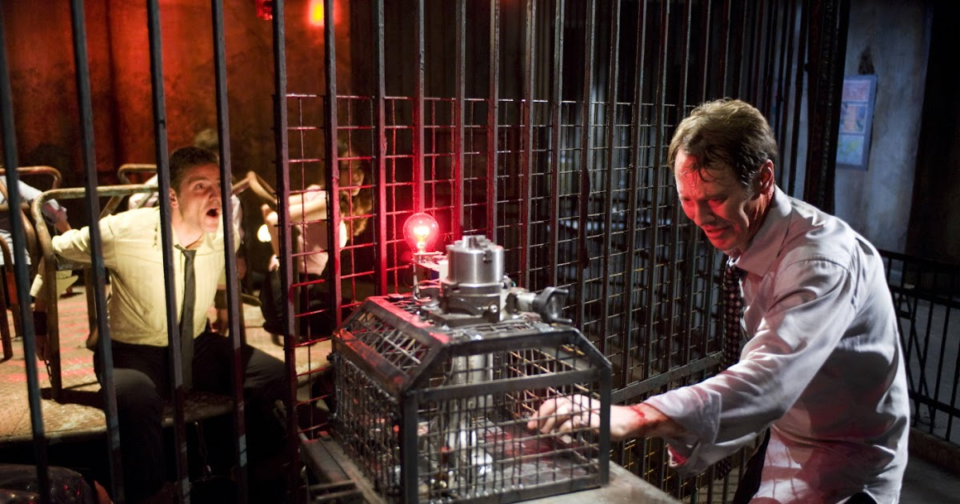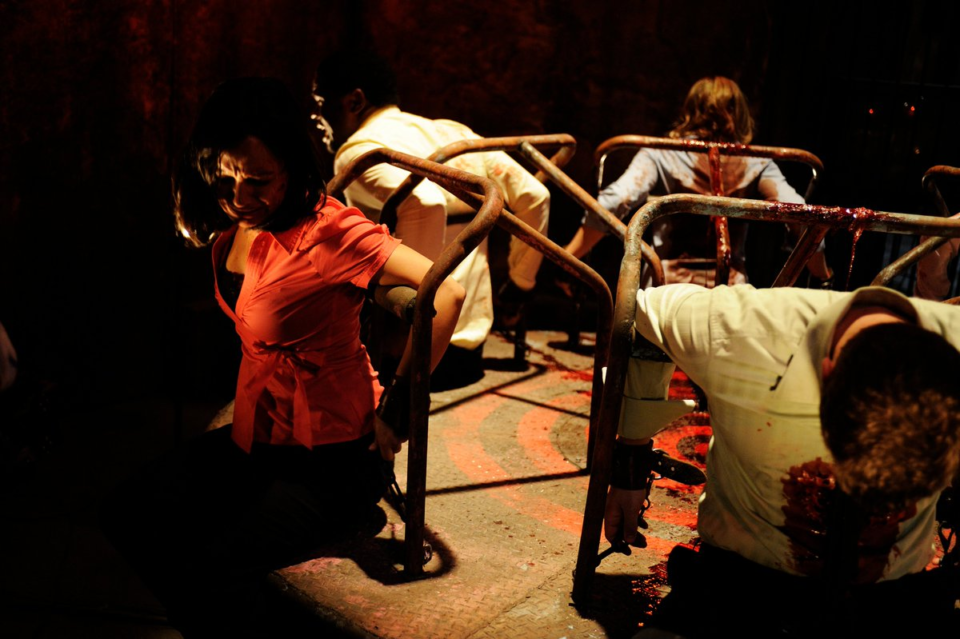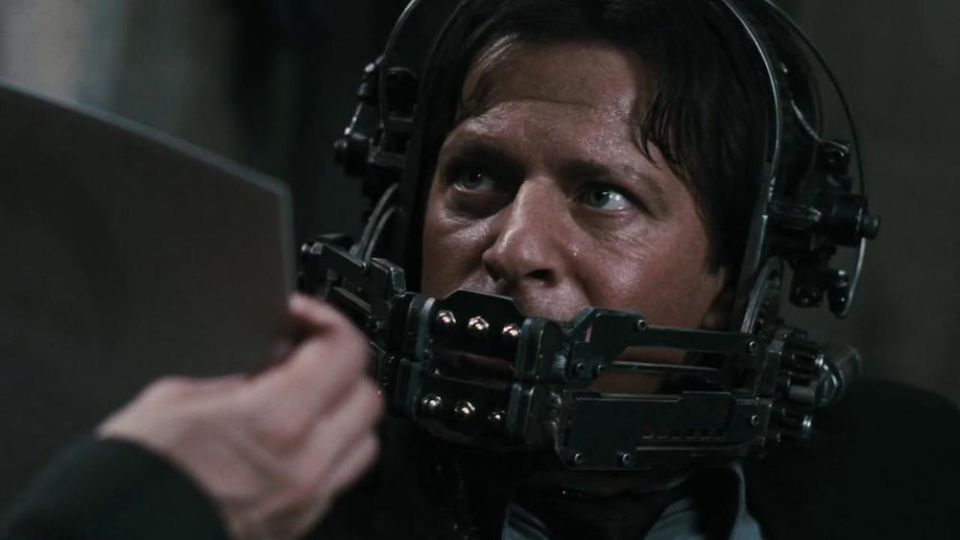‘Saw VI’ Is The Best Entry In The Franchise

Rev up the tricycle and get ready for some poetic justice via self-mutilation, because the one and only Jigsaw has returned to theaters in Saw X, the only entry to receive a Fresh rating on Rotten Tomatoes. After the eponymous franchise had been led by a series of apprentices, Tobin Bell’s John Kramer himself has returned, as this entry takes place between the first and second film. But Bell isn’t the only returning Saw alumni, because Saw X was directed by none other than Kevin Greutert, who’s most famous to Saw fans for having directed the fan-favorite Saw VI after having edited all the previous entries.
Greautert’s return for Saw X is particularly fitting because this new installment sees John Kramer targeting the doctors who failed him after he went to Mexico for an experimental procedure to cure his cancer. The same medical procedure is also his primary motivation for revenge in Saw VI after a greedy health insurance exec denies John Kramer coverage for the procedure.
Saw Gets Political
That’s right: Saw VI is where the franchise gets political and takes on the private health insurance industry, which was one of the most topical issues at the time this sequel came out in 2009. That was only a year after Barack Obama was elected, with a key campaign platform being that he would drastically reform the healthcare industry, where the average family was paying $13,375 annually in 2009.
Now, that was the social climate of 2009, but things were even more precarious for the Saw franchise. After killing off Jigsaw, the series started to see diminishing returns with Saw IV and Saw V, which centered around Detective John Hoffman carrying out Jigsaw’s legacy. It’s a testament to Jigsaw’s enduring popularity, and Hoffman’s personal lack of it, that the producers kept devising contrived means of bringing back John Kramer in a series of flashbacks. Sure they convoluted the timeline into a tangled web of contrivances, double-crosses, and a neverending series of apprentices. But it was good to have Tobin Bell back.
So after box-office returns started to plateau with the franchise after Saw V, and after the emerging Paranormal Activity franchise started to take over the Halloween season, it looked as if the once dominant franchise was well past its prime. Critics had long written off the series as “torture porn” and horror fans were starting to agree. After watching the monosyllabic Hoffman carry out Jigsaw’s legacy with traps that swapped out ingenuity with sheer dismemberment, it was hard not to get the impression that the Saw franchise had nothing left to offer. So to the surprise of audiences and critics, Saw VI actually received relatively favorable reviews and established itself as a fan favorite.
And for damn good reason. There’s a case to be made that Saw VI isn’t just the best Saw sequel, but the best entry in the franchise. Period. In fact, that’s the case I’m going to make today. Because if I had a Bear-Trap strapped to my head and the only way to diffuse it would be to name my favorite Saw flick, it would be this one.

Algorithms and Health Insurance
Is it just because I like to see health insurance agents and predatory lenders be tormented? Maybe. But very few tentpole horror franchises have risen to meet the moment of the sociopolitical zeitgeist so directly and condemned society’s true villains in the harshest terms. Finally, Jigsaw’s twisted morality and sordid games were turned upon a worthy foe, rather than the typical slate of junkies and petty criminals he’d been targeting.
This time, the central victim is Erickson, a private insurance executive who’s devised his own algorithm to assess if someone is financially viable to be granted coverage. Or, in Jigsaw’s words, Erickson chooses “who should live, and who should die.” Unfortunately for Erickson, though, one of those people he denied coverage was John Kramer himself, rendering him all but incapable of pursuing a procedure that could save his life.
So John asks Hoffman to exact a posthumous revenge scheme that sees Erickson being led through a labyrinth of traps that force him to sacrifice his employees. He’s quite literally being forced to choose who lives, and who dies. Except it’s not as personally gratifying when you’re a part of the equation. Erickson learns that the hard way as he allows his asthmatic janitor to get his lungs cleaved in.
A Left Turn For The Saw Franchise?
Saw skeptics have kept their reservations about the sixth installment by accusing it of pandering to an audience for political points. Isn’t the sixth film a little too late to be commenting on complex and sophisticated hot-button issues? Do the people who brought up Saw IV have anything insightful to bring to the healthcare discourse? If you cornered them, I’m not sure if you could get either the screenwriting team or Kevin Greutert himself to break down the numbers on the cost of premiums or out-of-pocket deductibles.
But what seems like a desperate left turn for the franchise is actually a logical avenue for the mythos of John Kramer. After all, his evolution into Jigsaw was chiefly inspired by his battle with a terminal illness. His primary target in the very first movie is his own doctor who failed to properly diagnose him. If there’s any slasher villain that shares our frustration with the healthcare system, it would be John Kramer.
In fact, this is the only Saw where John delivers his instructions to his victims without the use of either Billy the Puppet or one of his masks. It’s the most personal vendetta for the character yet because it speaks to the core of his entire mission. If John Kramer is about teaching us to value our lives, even if it’s through sadism, then what could be more encroaching on the sanctity of life than someone who turns mortality into a business model?
Politically charged or not, this is also the sequel that arguably takes the most advantage of the franchise’s moral premise. The traps of the Saw franchise are thematically effective in so far as they speak to the warped morality of its victim, not just about how gnarly they are. Don’t get me wrong, Saw VI is just as interested in delivering the gorehounds. It certainly delivers sequences that continue to make me squirm even on rewatch, even when it’s being inflicted upon characters that I hold nothing but contempt for. Gore is the special sauce in Saw VI, but it’s not the secret ingredient.
Carousels and Drills And Blood, Oh My: The Traps of Saw VI
Saw VI announces its politically charged intentions with the first trap, one of many highlights of horror that this sequel has to offer. Two predatory lenders awaken with drills strapped to their heads. The only one of these two who’ll be spared is the one who can cut off the most amount of meat from their body. In a move that would make Shylock blush, Hoffman’s Jigsaw is forcing them to offer a pound of flesh. Outside of the social implications of watching two predatory lenders dismember themselves only a year after the Housing Market Crash of 2008, the frantic but refined editing immerses you the whole way through until the bloody conclusion. After a sequence of such organized chaos, I knew we’d be in good hands with Kevin Greutert.

That’s not the best trap of the film. Oh no. People can debate the best traps of the franchise, and there are many contenders, but no trap so perfectly confronts the victims with their own moral failures than the Carousel trap, easily the centerpiece of this sequel. Instead of subjecting just one or two victims to a vengeful game, Jigsaw forces Erickson to choose two out of six of his personnel to spare in a zero-sum roulette of death.
The rest of the six will be shot point blank with a shotgun, but not before they get a chance to make their case to their boss about why “they” should be spared in favor of their colleagues. One of them is pregnant, one of them has seniority, etc. If only Erickson could save them all, but instead he must choose who will live, and who will die. Instead of corporate profits, though, he’s treated to a drill through each of his hands as he pulls the proverbial trigger.
Better Acting Than Seen Before In The Series
You can clown on Saw for its history of laughable performances (I’m actually a Cary Elwes defender, and not just because my wife says I look like him), but outside of Tobin Bell himself, this series has never had higher caliber acting than this entire sequence. This Carousel of Hell isn’t sold by the size of the squibs or the amount of blood that’s discharged but by the performances. That’s why it’s harder to watch than the more objectively grotesque setpieces throughout the franchise because, perhaps for the first time, I actually felt like I was watching real people be subjected to one of these traps.
Of course, Tobin Bell still steals the film even with his limited screen time. If Tobin Bell ever selected one clip from his career to campaign for an Academy Award, I’d hope it would be his little “Pirhana” speech to Erickson. It’s one of Jigsaw’s most animated moments, a departure from his typical understated monotone, and perfectly summarizes the film’s thesis.
Enter Detective Hoffman
Of course, the Erickson storyline is just one half of the equation behind Saw VI. Like the other sequels, there screenplay is divided into two parallel storylines, one of the victims making their way through Jigsaw’s game, and the other the police efforts to finally capture Jigsaw. As with the past few entries, that puts an outsized burden of dramatic tension on the shoulders of Hoffman, played by Costas Mandylor. I’m less enthusiastic to defend this half of the film’s storyline, which continues the pattern of retcons and contrivances to seemingly expand the mythos of Jigsaw.

Many have accused Saw VI of being the moment where the series undeniably jumped the shark, probably because of the revelation that Jigsaw entrusted his own widow, played by Betsy Russell, of singlehandedly putting an end to Hoffman’s mayhem. Not winning Husband of the Year any time soon, and it’s no surprise that Jill Kramer isn’t able to complete her husband’s mission. This means that we have just another cliffhanger to an inevitable Saw sequel, and the personal stakes of Jigsaw’s game have never felt more muddled. Why did he entrust his legacy to a man whose entirely uninterested in giving his victims a chance to survive? Wasn’t the whole point of Jigsaw’s schtick that he was rehabilitating these people?
Still, Saw VI eclipses the other sequels in this department if not for the fact that it finally turns Hoffman into a formidable force of his own. Don’t get it twisted: he’s no John Kramer, whose presence is still missed whenever Tobin Bell is on screen. The series would have probably been wiser to pass the baton off to Amanda, who instead dies with her mentor in Saw III. That being said, the screenwriters were wise enough to compensate for Hoffman’s thin characterization by making him more personally lethal and dangerous than his predecessors. Not only is he a cop who’s working on the inside of the force, but he’s more physically menacing than John Kramer.
“There Was A Fire Fight”: The Saw VI Precinct Massacre
Easily Hoffman’s stand-out sequence, and perhaps the scene where he finally comes alive to me, is his massacre in the precinct. In one of the more outright suspenseful sequences of the Saw franchise, Hoffman has to sit there with his partners as they attempt to decode the latest Jigsaw message. Of course, it’s just Hoffman using a voice modulator. As they continue to decode the message, Hoffman squirms in his chair as his whole world threatens to crumble around him. We’re forced to wonder just what Hoffman will resort to if his colleagues finally discover his true identity. It’s a taut, tense set-up, and the resolution doesn’t disappoint.
Without missing a beat, Hoffman grabs the nearest sharp objects and starts going to town. Not in the mode of a slasher villain, but a tactful soldier. With precision and deliberation, he mows his way through the entire force in a rather glorious sequence. Some would lament that a franchise based on traps has resorted to a scene of flagrant butchery in this fashion. It’s too refreshing for me to agree, and it’s executed too well (no pun intended) for me to consider it dumbing down. Besides, it’s hard to “dumb things down” after Saw V.
So accuse the Saw producers of pandering with this direction, if you will, but I’m for one grateful that they went with this direction instead of the original plan, which was to have Hoffman face off against *checks notes* the Mafia? Lionsgate already had a Punisher flick coming out a year prior, they didn’t need another one.
The Surprising Vincent Price Connection to Saw VI
If all that doesn’t convince you, I’ll state one last line of defense, which is that Saw VI’s plotline of medical vengeance and oh-so-ironic murder traps has a precedent in classic horror. I couldn’t help but watch this and think of one of my favorite Vincent Price flicks, The Abominable Dr. Phibes.
Price, playing the eponymous mad genius, spends the film murdering the doctors who failed to save his wife on the operating table. He does so with a series of tongue-in-cheek traps that are modeled off of the Ten Plagues of Egypt. Dr. Phibes had already been cited as a predecessor to Saw after the first film, so it appeared that the franchise was fulfilling its destiny by harkening back to these roots. It wasn’t likely a direct nod or conscious influence, but I’d rather think of Saw as this generation’s answer to Vincent Price drive-ins and not so much the culprit of the Torture Porn boom.
In Short, Saw VI Is Good
Between its wit and its wickedness, I continue to endorse Saw VI as the franchise’s final hour. That won’t be much to the community of Saw skeptics out there, and I’m not sure how many diehard fans would consider this their favorite. Frankly, I’m shocked that I haven’t heard more complaints about how woke this sequel is.
I’m still not sure if Saw VI transcends the limitations of its series, and I wouldn’t argue with anyone that it still accuses it of playing by the Torture Porn playbook. It’s not exactly Elevated Horror. For me, it’s a classic punk song: it’s only got three chords, but it plays them with righteous fury. Some might complain that tying itself to such a topical issue like healthcare would date the movie, but it’s remained depressingly relevant. As long as we have assholes who prioritize profits over people, there will always be a place for Saw VI. So don’t expect it to go away anytime soon. The reality is that at the rate things are going, we need Jigsaw more than ever.
Categorized:Editorials

